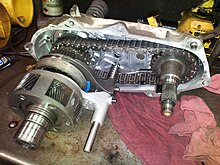Transfer case
Transfer cases are gearboxes that divide the input torque over several outputs. They are often used as differential gears in vehicles in order to compensate for different speeds of the driven wheels or axles.
Application in motor vehicles
A transfer case is often used in motor vehicles with all-wheel drive and is usually attached in the power flow after the vehicle transmission. There it distributes the torque generated by the engine and translated by the vehicle transmission to two driven axles or axle drives with through drive, if the vehicle has more than 2 axles. (e.g. with all-wheel-drive three-axle 6 × 6 trucks), depending on the design with permanent through drive or through drive that can be switched by the driver.
The transfer case is characterized by one or more of the following components:
- Installation position (seen from the engine in the direction of the power flow) after the vehicle transmission
- With differential-controlled all-wheel drive: A differential or a planetary gear that divides the power between two output shafts
- With clutch-controlled all-wheel drive: A rigid clutch without speed compensation or an automatic clutch (e.g. Visco clutch , Haldex clutch ) or completely without a clutch, for example if these are switched on the wheels ( freewheel hubs )
- A chain (inexpensive) or a gear set if an offset of an output shaft is required
If a vehicle has a transfer case, then more than one axle can always be driven. For trucks, for example, there are 6 × 4 or 6 × 6 drive concepts. H. of 6 wheels, 4 (6 × 4) or all 6 (6 × 6) are driven. One or two transfer cases are necessary here.
